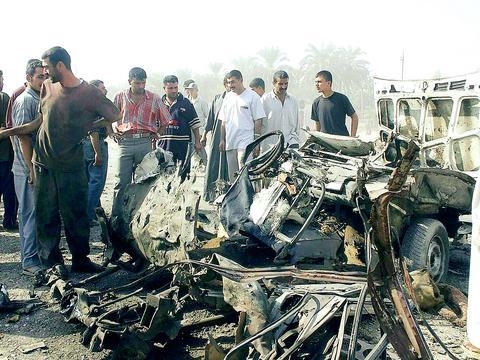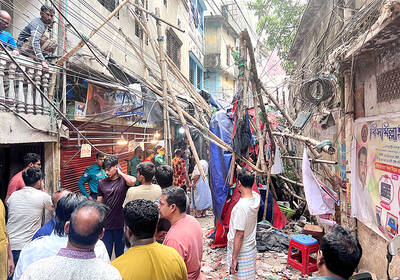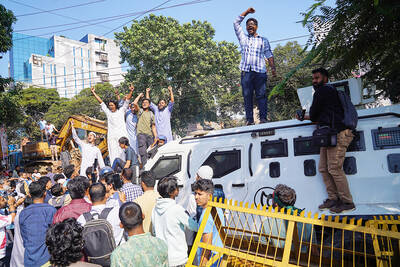An estimated 100,000 civilians have died in Iraq as a direct or indirect consequence of last year's US-led invasion, according to a new study by a research team at the Bloom-berg School of Public Health at Johns Hopkins University in Baltimore.
Coming just a few days before the presidential election the finding is certain to generate intense controversy, since it is far higher than previous mortality estimates for the Iraq conflict.

PHOTO: EPA
Editors of The Lancet, the London-based medical publication, where an article describing the study is scheduled to appear, decided not to wait for the normal publication date next week, but to place the research online yesterday, apparently so it could circulate before the election.
The Bush administration has not estimated civilian casualties from the conflict, and independent groups have put the number at most in the tens of thousands.
In the study, teams of researchers led by Dr. Les Roberts fanned out across Iraq in the middle of last month to interview nearly 1,000 families in 33 locations. Families were interviewed about births and deaths in the household before and after the invasion.
Although the authors acknowledge that thorough data collection was difficult in what is effectively still a war zone, the data they managed to collect is extensive. Using what they described as the best sampling methods that could be applied under the circumstances, they found that Iraqis were 2.5 times more likely to die in the 17 months following the invasion than in the 14 months before it.
Before the invasion, the most common causes of death in Iraq were heart attacks, strokes, and chronic diseases. Afterward, violent death was far ahead of all other causes.
"We were shocked at the magnitude but we're quite sure that the estimate of 100,000 is a conservative estimate," said Dr. Gilbert Burnham of the Johns Hopkins team.
Burnham said the team excluded data about deaths in Fallujah in making their estimate, because that city was the site of unusually intense violence.
In 15 of the 33 communities visited, residents reported violent deaths in their families since the conflict started.
They attributed many of those deaths to attacks by US-led forces, mostly airstrikes, and most of those killed were women and children. The risk of violent death was 58 times higher than before the war, the researchers reported.
The team included researchers from the Johns Hopkins Center for International Emergency, Disaster and Refugee Studies, which has conducted similar mortality studies about North Korea and Congo.
It also included doctors from Al Mustansiriya University Medical School in Baghdad.
There is bound to be skepticism about the estimate of 100,000 excess deaths, since that translates into an average of 166 deaths a day since the invasion.
But some people were not surprised.
"I am emotionally shocked but I have no trouble in believing that this many people have been killed," said Scott Lipscomb, an associate professor at Northwestern University, who works on the www.iraqbodycount.net project.
That project, which collates only deaths reported in the news media, currently put the maximum civilian death toll at just under 17,000.
"We've always maintained that the actual count must be much higher," Lipscomb said.

DISASTER: The Bangladesh Meteorological Department recorded a magnitude 5.7 and tremors reached as far as Kolkata, India, more than 300km away from the epicenter A powerful earthquake struck Bangladesh yesterday outside the crowded capital, Dhaka, killing at least five people and injuring about a hundred, the government said. The magnitude 5.5 quake struck at 10:38am near Narsingdi, Bangladesh, about 33km from Dhaka, the US Geological Survey (USGS) said. The earthquake sparked fear and chaos with many in the Muslim-majority nation of 170 million people at home on their day off. AFP reporters in Dhaka said they saw people weeping in the streets while others appeared shocked. Bangladesh Interim Leader Muhammad Yunus expressed his “deep shock and sorrow over the news of casualties in various districts.” At least five people,

LEFT AND RIGHT: Battling anti-incumbent, anticommunist sentiment, Jeanette Jara had a precarious lead over far-right Jose Antonio Kast as they look to the Dec. 14 run Leftist candidate Jeannette Jara and far-right leader Jose Antonio Kast are to go head-to-head in Chile’s presidential runoff after topping Sunday’s first round of voting in an election dominated by fears of violent crime. With 99 percent of the results counted, Jara, a 51-year-old communist running on behalf of an eight-party coalition, won 26.85 percent, compared with 23.93 percent for Kast, the Servel electoral service said. The election was dominated by deep concern over a surge in murders, kidnappings and extortion widely blamed on foreign crime gangs. Kast, 59, has vowed to build walls, fences and trenches along Chile’s border with Bolivia to

DEATH SENTENCE: The ousted leader said she was willing to attend a fresh trial outside Bangladesh where the ruling would not be a ‘foregone conclusion’ Bangladesh’s fugitive former prime minister Sheikh Hasina yesterday called the guilty verdict and death sentence in her crimes against humanity trial “biased and politically motivated.” Hasina, 78, defied court orders that she return from India to attend her trial about whether she ordered a deadly crackdown against the student-led uprising that ousted her. She was found guilty and sentenced to death earlier yesterday. “The verdicts announced against me have been made by a rigged tribunal established and presided over by an unelected government with no democratic mandate,” Hasina said in a statement issued from hiding in India. “They are biased and politically motivated,” she

It is one of the world’s most famous unsolved codes whose answer could sell for a fortune — but two US friends say they have already found the secret hidden by Kryptos. The S-shaped copper sculpture has baffled cryptography enthusiasts since its 1990 installation on the grounds of the CIA headquarters in Virginia, with three of its four messages deciphered so far. Yet K4, the final passage, has kept codebreakers scratching their heads. Sculptor Jim Sanborn, 80, has been so overwhelmed by guesses that he started charging US$50 for each response. Sanborn in August announced he would auction the 97-character solution to K4